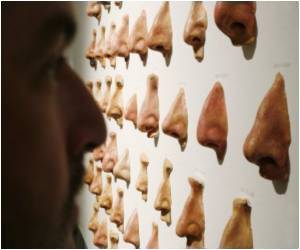Similar to a GPS in a vehicle, brain registers many aspects of our physical world. In the somatosensory cortex sensory inputs from our fingers are mapped next to each other.

When researchers at the Stowers Institute for Medical Research traced individual odor molecules' signal deep into the brain, they found evidence that this "chemotopic" hypothesis of olfaction is insufficient, paving the way for a new model of how the sense of smell works, and how it came about.
"When we mapped the individual chemical features of different odorants, they mapped all over the olfactory bulb, which processes incoming olfactory information," says Associate Investigator C. Ron Yu, PhD, who led the study published in this week's online edition of the Proceedings of the National Academy of Sciences. "From the animal's perspective that makes perfect sense. The chemical structure of an odor molecule is not what's important to them. They really just want to learn about their environment and associate olfactory information with food or other relevant information."
The brain receives information about odors from olfactory receptors, which are embedded in the membrane of sensory neurons in the nasal cavity. Any time an odor molecule interacts with a receptor, an electrical signal travels to so-called glomeruli in the olfactory bulb. Each glomerulus receives input from olfactory receptor neurons expressing only one type of olfactory receptor. The overall glomerular activation patterns within the olfactory bulb are thought to represent specific odors.
"Chemotopy is a very attractive model," says Yu. But it had never been mapped accurately based on the earlier available technologies and recent experiments suggested that the chemotopic hypothesis breaks down at a fine level. To increase the resolution of the "olfactory map," Yu and his team generated a new line of transgenic mice with superb sensitivity and devised equipment that allowed them to deliver hundreds of odor stimuli to a single mouse.
When the Stowers researchers examined the activation pattern at the level of single glomeruli, they found that certain odors activated glomeruli within a distinct area of the olfactory bulb, while others signaled to glomeruli located all over the map. Odors from different classes intermingled, too, suggesting that the glomeruli have not evolved to only detect the chemical shapes of specific odorants.
Advertisement
So if glomeruli didn't have a fidelity to certain molecular shapes, as the chemotopic hypothesis had suggested, what did unite them? The team was led to a "tunotopic" hypothesis of the olfactory system. Individual olfactory receptors are "tuned" during evolution not to one particular kind of odorant, but to a variety of molecules. In combination, these receptors can then respond to those millions of smells. Glomeruli with similar tuning properties tend to be near each other. From a computing standpoint, this arrangement helps to enhance contrast among similar odors, explains Ma.
Advertisement
Imagine a roomful of musicians. In chemotopy, the musicians are clustered according to their instruments and never play with other instruments. The team's tunotopic hypothesis is closer to an actual symphony: Different instruments overlap to create many more different sounds than the individual ones could.
Yu and his team think, further, that the tunotopic hypothesis may help us understand visual, auditory, and somatosensory processing as well. In the case of olfaction, tunotopy allows the animal to better distinguish among the nuances of odors. That precision, from an evolutionary perspective, would come in handy as the animal sorted through its environment.
It also helps us adapt to a constantly changing world.
"When you have a new chemical synthesized, like new perfumes and food flavors, you don't have to create new brain regions to react to it," says Ma. "What you do is use the existing receptors to sense all these chemicals and then tell your brain whether this is novel, whether it's similar, or whether it's something really strange."
Source-Eurekalert









